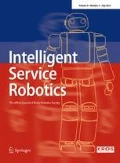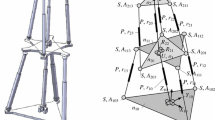Abstract
In this paper, a method has been proposed to analyze the planar architectures of serial and parallel manipulators, based on the duality associated with their interconnected kinematics. The interconnected kinematics states that model of one architecture can be derived from the kinematic model of the other, using screw theory approach. The performance of the initial and the derived manipulators was evaluated with three criteria: isotropy, maximum force transmission ratio and local transmission index. Without loss of generality, the serial manipulator derived from parallel has better isotropy, while the parallel manipulator derived from serial can be designed to have better force and power transmission.






















Similar content being viewed by others
References
Pandilov Z, Dukovski V (2014) Comparison of the characteristics between serial and parallel robots. Acta Technica Corvininesis-Bull Eng 7(1):144–160
Denavit J (1955) A kinematic notation for low pair mechanisms based on matrices. ASME J Appl Mech 22:215–221
Rocha C, Tonetto C, Dias A (2011) A comparison between the Denavit–Hartenberg and the screw-based methods used in kinematic modeling of robot manipulators. Robot Comput Integr Manuf 27(4):723–728
Ball R (1900) A treatise on the theory of screws. Cambridge University Press, London
Duffy J (1996) Statics and kinematics with applications to robotics. Cambridge University Press, Cambridge
Kang L, Yi B (2016) Design of two foldable mechanisms without parasitic motion. IEEE Robot Autom Lett 1(2):930–937
Ni Y, Zhang B, Sun Y, Zhang Y (2016) Accuracy analysis and design of A3 parallel spindle head. Chin J Mech Eng 29(2):239–249
You WS, Lee YH, Kang G, Oh HS, Seo JK, Choi HR (2019) Kinematic design optimization for anthropomorphic robot hand based on interactivity of fingers. Intel Serv Robot 12(2):197–208
Waldron KJ, Hunt KH (1991) Series-parallel dualities in actively coordinated mechanisms. Int J Robot Res 10(5):473–480
Gosselin F, Lallemand J-P (2001) A new insight into the duality between serial and parallel non-redundant and redundant manipulators. Robotica 19(4):365–370
Lee S, Yi B-J, Kwak YK (1997) Optimal kinematic design of an anthropomorphic robot module with redundant actuators. Mechatronics 7(5):443–464
Park TB, Lee JH, Yi B-J, Kim WK, You BJ, Oh S-R (2002) Optimal design and actuator sizing of redundantly actuated omni-directional mobile robots. In: ICRA, pp 732–737
Kang L, Kim SH, Kim WK, Yi B-J (2019) Review of Dimension Inhomogeneity in Robotics. In: 2019 16th International Conference on Ubiquitous Robots (UR). IEEE, Jeju, Korea, pp 143–148
Wang J, Wu C, Liu X-J (2010) Performance evaluation of parallel manipulators: motion/force transmissibility and its index. Mech Mach Theory 45(10):1462–1476
Acknowledgements
This work was supported by the Technology Innovation Program (or Industrial Strategic Technology Development Program-Artificial intelligence bio-robot medical convergence project) (20001257, Artificial intelligence algorithm-based vascular intervention robot system for reducing radiation exposure and achieving 0.5 mm accuracy) funded by the Ministry of Trade, Industry and Energy (MOTIE, Korea), the Ministry of Health and Welfare (MOHW), Ministry of Science and ICT (MSIT), Korea Evaluation Institute of Industrial Technology (KEIT), supported by the Technology Innovation Program (10052980, Development of microrobotic system for surgical treatment of chronic total occlusion) funded by the Ministry of Trade, Industry and Energy, Korea, and supported by the BK21 Plus Program funded by National Research Foundation of Korea (NRF).
Author information
Authors and Affiliations
Corresponding author
Additional information
Publisher's Note
Springer Nature remains neutral with regard to jurisdictional claims in published maps and institutional affiliations.
Appendix
Appendix
1.1 Inverse of matrix having axis coordinates
Consider three lines \( \hat{S}_{1} ,\,\,\hat{S}_{2} , \) and \( \hat{S}_{3} \) having coordinates (\( x_{1} \), \( y_{1} \)), (\( x_{2} \), \( y_{2} \)) and (\( x_{3} \), \( y_{3} \)) as shown in Fig. 23. The matrix Q can be written as
The inverse of \( Q \) can be expressed as
Adjoint matrix can be constructed as follows
Substituting (66) into (65), we get
Let \( \hat{s}_{2} , \)\( \hat{s}_{3} \) and \( \hat{s}_{1} \) are the column vectors formed by the unitized coordinates of the lines joining the points 2-3, 3-1 and 1-2, respectively, where \( u_{23} \) given by
is denoted as the distance between two points. Then,
where \( \hat{s}_{2}^{T} = \left[ {c_{2} ,s_{2} ;\,p_{2} } \right]. \)
Now, (65) can be expressed as
where
Similarly,
Finally, substituting (71) through (73) into (70), we have
where \( \hat{s}_{1}^{T} = \left[ {c_{1} ,s_{1} ;p_{1} } \right] \), \( \hat{s}_{2}^{T} = \left[ {c_{2} ,s_{2} ;p_{2} } \right] \) and \( \hat{s}_{3}^{T} = \left[ {c_{3} ,s_{3} ;p_{3} } \right]. \)
It is noted that the three rows of (74) are lines expressed in ray coordinates. Therefore, it is remarked that the initial matrix \( Q \) composed of three lines expressed by axis coordinate is converted into ray coordinate as a result of matrix inversion.
1.2 Inverse of matrix having ray coordinates
Assume that we have three lines \( \hat{s}_{1} ,\,\,\hat{s}_{2} \) and \( \hat{s}_{3} \) in plane as shown in Fig. 23. They can be expressed in ray coordinate. The matrix E having ray coordinates can be written as follows
Then, the inverse of \( E \) can be expressed in the following way
and it adjoint matrix can be constructed as follows
Using Grassmann’s expansion given in (12) through (14), the point of intersection \( (x_{1} ,y_{1} )\, \) of lines \( \hat{s}_{1} ,\,\,\hat{s}_{2} \) can be solved by
Rearranging (78) would result in
Similarly, the first and the second columns of (77) can be expressed, respectively, as
and
Putting (79) through (81) into (76), we can get
Expanding determinant with respect to the first column of (77), we have
Similarly, for the second and third columns, we have
Finally, inserting (83) through (85) into (82), we have
It is noted that the three rows of (86) are lines expressed in axis coordinates. Therefore, it is remarked that the initial matrix \( E \) composed of three lines expressed by ray coordinate is converted into lines in axis coordinate as a result of matrix inversion.
Rights and permissions
About this article
Cite this article
Iqbal, H., Khan, M.U.A. & Yi, BJ. Analysis of duality-based interconnected kinematics of planar serial and parallel manipulators using screw theory. Intel Serv Robotics 13, 47–62 (2020). https://doi.org/10.1007/s11370-019-00294-7
Received:
Accepted:
Published:
Issue Date:
DOI: https://doi.org/10.1007/s11370-019-00294-7





